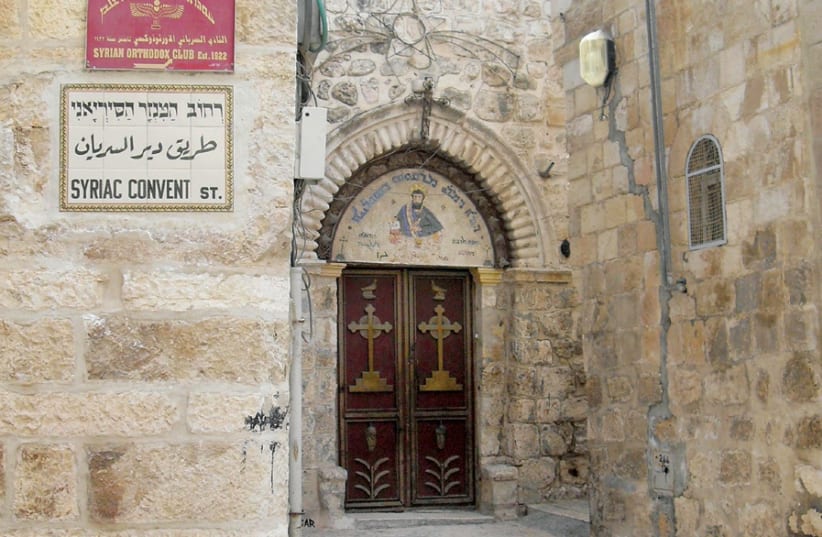Something about Benjamin Balint bewilders me. He writes wonderfully compelling books like his last, Kafka’s Last Trial, but holds back somehow. It feels as if he has decided to stay on the sidelines, or perhaps he is uncomfortable sharing with us his most private or provocative thoughts. There is a cautiousness about him. There is something about him that seems heartbroken, or perhaps resigned to life’s powerlessness. And that comes through in his latest work, one he co-authored with Merav Mack, an effervescent historian of crusading history and religion at the Hebrew University of Jerusalem.
In their new collaboration, Jerusalem: City of the Book, the authors – by visiting Jerusalem’s religious libraries and archives and speaking with the librarians who safeguard these sacred treasures – attempt to dissect how Jerusalem has captured the world’s imagination.
Both authors express an enthusiasm for the incredible diversity that exists in Jerusalem and the fact that so many microscopic worlds of religious beliefs and languages and customs often exist within feet of one another, yet somehow are siphoned off into their own impenetrable realms.
“Reading Jerusalem is like deciphering a palimpsest, a text in which one layer has been written over an old layer without erasing the text beneath,” they write. “A palimpsest does not eradicate memory so much as it appropriates and recycles earlier memories. We attempt to read Jerusalem as a conversation among languages, in which writers reached for each other across the centuries.”
But the reader senses that this is an ambitious undertaking, one that may be more idealistic than real. Their visits with various holy men reinforce our sense that these meetings aren’t the freewheeling exchanges the authors might have desired, but carefully scripted and sometimes even staged presentations that attempt to present their people’s history in the grandest light. There is a sense of secrecy that prevails, the desire to withhold more than share. The “conversations among languages” the authors long for feel constricted at best.
Mack and Balint visit the Church of Saint Mark in the Christian Quarter, where several hundred Syriac Christians live near the church that was purchased by the Copts in the 1470s. Today it houses a handful of monks in a community who speak Aramaic.
Abuna Shimon Can, a monk whose native tongue is Syriac, is the man in charge. He was born in 1951 in southeastern Anatolia, and has been trying to save the library from falling into further disrepair. He is distressed by the fact that a handwritten catalogue of 289 volumes compiled in 1926 is now missing, even thought they had been available just a few short years ago. They had been sent to Damascus and have never been returned.
BROTHER CAN shows the authors a worn manuscript, dated 1474, written by a Jewish-born 13th-century bishop of Aleppo named Jacob of Serug. It is a poetic homily, its margins filled with notes made by Mar Athanasius Samuel. Aside from the joy of seeing this ancient manuscript, the meeting between the monk and the authors feels thwarted. Neither author offers any insight into what they gained from the experience other than a sense that these libraries and librarians seem to be invested in holding on to their secrets.
Similar experiences follow. The authors were able to meet with the son of Yitzhak Nissim, who was the chief Sephardi rabbi of Israel from 1955-1972. Meir Benayahu showed them an extraordinary number of manuscripts that were known to have been produced and copied in the 16th century during the Mamluk period that came from Jews who were expelled from Spain in 1492.
Even while admiring the various intricate models of Jerusalem that are prominently displayed throughout the city, the authors seem to rely on reportage over analysis as to the motivating drives behind such works. They tell us about the Jerusalem model created over the course of 21 years by Richard Harvey that is on display at Safra Square; the model made of strips of beaten zinc in the Tower of David Museum beside the Jaffa Gate that depicts a 19th-century Jerusalem; and the rendering of the First Temple created by archeologist Dan Bahat which sits in the heart of the Jewish Quarter. But they offer little about their response to the works or the public response or any biographical information about the various artists.
The authors refrain from asking the questions that seem most pressing. Why is necessary for these sacred places to remain so enclosed and inaccessible to both scholars and lay people? What role can these places maintain as secularism and nationalism and ethnocentrism become more prevalent in our modern world? What is the Israeli government’s role in protecting the sanctity of these places that offer competing worldviews to the Jewish one? How can this information be digitized before it is lost forever?
Balint and Mack are clearly enthralled with their subject matter, but forget that the rest of us need to be brought along with them. We never get a sense of where either of them resides on the religious paradigm or get to know anything else about them. Their entire project seems enigmatic to us, as do their arduous struggles to convince hesitant rabbis and priests to grant them access to these rarities. They offer no commentary about the restrictiveness of these worlds and their cloistered nature or their male dominance. They remain invisible entities hiding behind their intellectual inquiry, in a manner similar to the religious men they speak with who hide behind their holy beliefs.
